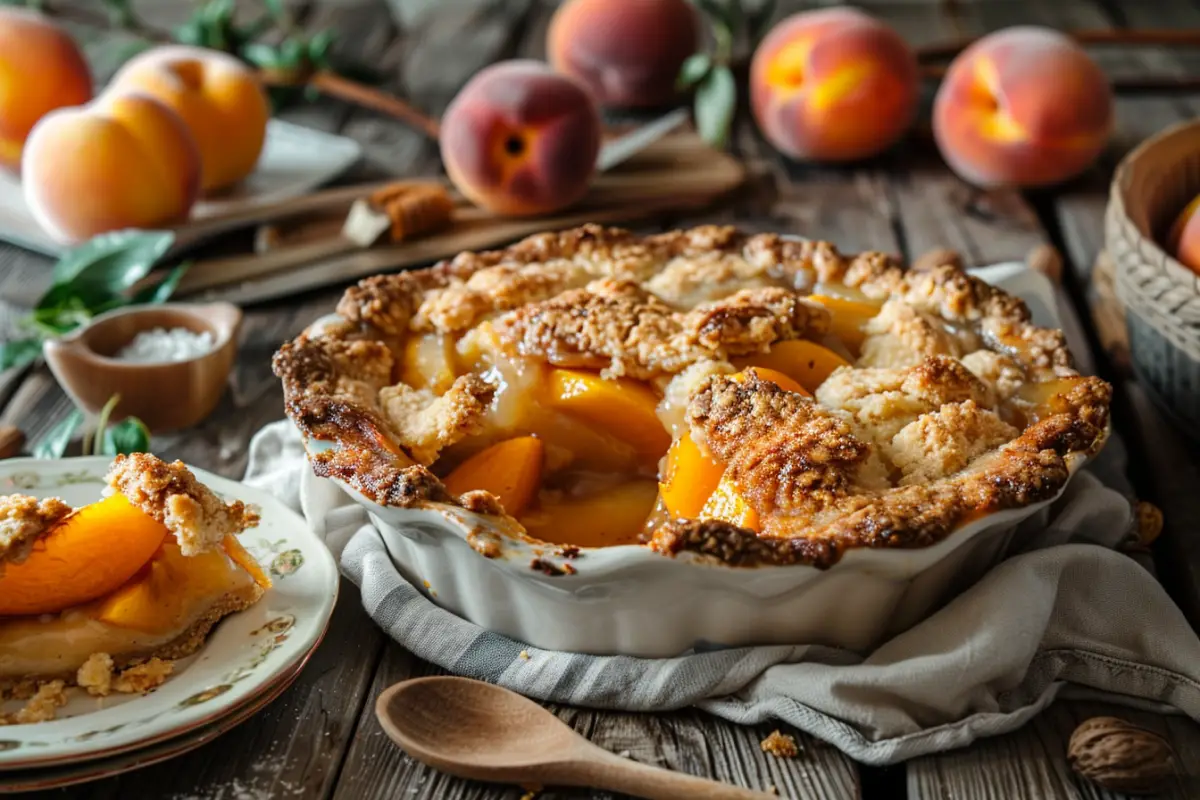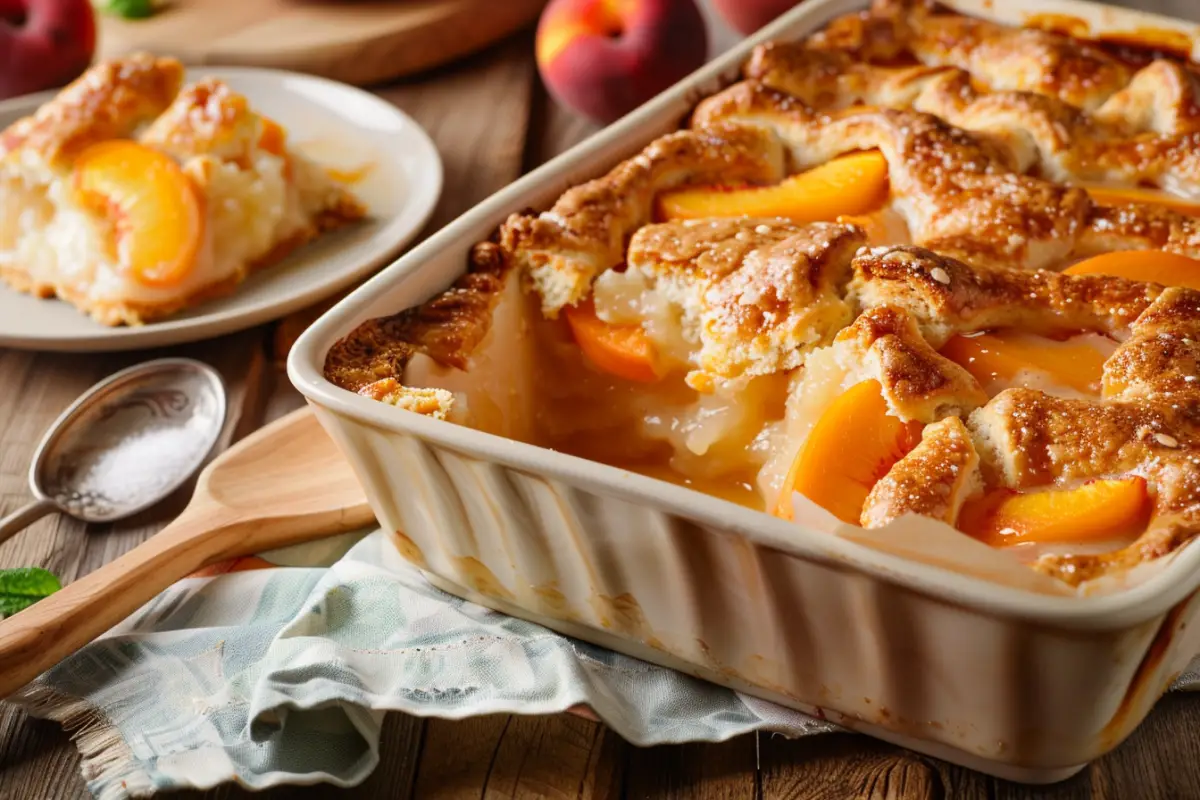If you’ve ever tried your hand at baking a cobbler, you probably had high hopes for that classic, crispy topping over sweet, syrupy fruit. But what if your cobbler ended up looking (and tasting) more like cake? Don’t worry, you’re not alone. Many home bakers find themselves asking, “Why did my cobbler turn out like cake?” The good news is, there are several common reasons this happens, and with a few adjustments, you can bake the perfect cobbler every time.
In this article, we’ll explore why cobblers sometimes resemble cake instead of the traditional dessert you were aiming for. We’ll break down the common mistakes and provide solutions to make sure your next cobbler is just right.
Understanding What Cobbler Is Supposed to Be
What Is a Traditional Cobbler?
A classic cobbler is a fruit-based dessert that is topped with a biscuit-like dough or batter, baked until the fruit is bubbling and the topping is golden brown and crisp. The name “cobbler” comes from the dessert’s rustic, “cobbled-together” appearance, with the topping often being spooned or dolloped onto the fruit rather than spread evenly.
Cobblers can be made with various fruits, like peaches, berries, or apples, but the key is the contrast between the juicy fruit filling and the cobbler topping.
How Cobbler Differ from Cake
The main difference between a cobbler and a cake lies in their texture and structure:
- Cobblers: The topping is biscuit-like or doughy, offering a chewy, slightly crispy finish that contrasts with the soft fruit underneath. The topping may be dense but should never resemble a sponge cake.
- Cakes: On the other hand, cakes are light, fluffy, and uniform in texture throughout. If your cobbler turned out like cake, it may be because the batter was too thin, or you used too much liquid.
Now that you understand what a cobbler should be, let’s dive into the most common reasons it might turn out like cake.
Common Reasons Your Cobbler Turned Out Like Cake

1. Too Much Liquid in the Fruit Filling
One of the most common reasons a cobbler turns out like cake is too much liquid in the fruit filling. When the fruit releases excess juice during baking, the liquid can mix with the topping, creating a sponge-like texture that resembles a cake.
How to Fix a Cobbler that Turned Out Like Cake:
- Drain canned fruit: If you’re using canned fruit, make sure to drain the liquid before adding it to the dish. This prevents the excess syrup from making the cobbler too moist.
- Thicken fresh fruit: For fresh fruit, especially juicy varieties like peaches or berries, consider tossing them with a bit of cornstarch or flour before layering them in the baking dish. This helps absorb some of the fruit juices as they bake.
2. Using the Wrong Batter or Topping Recipe means Your Cobbler Turned Out Like Cake
Not all cobbler recipes are created equal. If you accidentally use a topping recipe meant for a cake rather than a biscuit-style topping, your cobbler will definitely turn out like cake.
How to Fix a Cobbler that Turned Out Like Cake:
- Check the recipe: Ensure that the recipe you’re using calls for a true cobbler topping, not a cake batter. Cobbler toppings are typically thicker and less sweet than cake batter, often using baking powder for leavening instead of relying on a lot of sugar or eggs.
- Biscuit or batter?: Decide if you prefer a biscuit-like topping or a thinner batter-style topping. Either can work, but a biscuit topping will give you a more authentic cobbler texture.
3. Overmixing the Batter
Overmixing the batter can be another reason your cobbler turns out like cake. When you mix too much, you incorporate extra air into the dough, which can make the topping rise more than it should and take on a cake-like texture.
How to Fix a Cobbler that Turned Out Like Cake:
- Mix lightly: When making your cobbler topping, be careful not to overmix. Stir just until the ingredients are combined to avoid creating too much air in the batter.
- Fold gently: If your recipe calls for folding ingredients together, do so gently to keep the batter light but not too fluffy.
4. Incorrect Baking Temperature means Your Cobbler Turned Out Like Cake
Baking your cobbler at the wrong temperature can also result in a cake-like texture. If the oven is too low, the topping may not crisp up properly, leaving you with a soggy, cake-like result.
How to Fix It:
- Bake at the right temperature: Most cobblers should be baked at 350°F (175°C) to 375°F (190°C). This range ensures that the topping gets golden and crispy while the fruit becomes soft and bubbly.
- Check for doneness: Your cobbler is done when the topping is golden brown, and the fruit is bubbling up around the edges. If the topping is pale, let it bake a bit longer to develop that perfect crispness.
5. Using the Wrong Type of Flour
Did you know that the type of flour you use can affect whether your cobbler turns out like cake? Using self-rising flour, which already has baking powder mixed in, can cause the topping to rise too much, mimicking a cake texture.
How to Fix It:
- Use all-purpose flour: Stick to all-purpose flour for your cobbler topping unless the recipe specifically calls for self-rising flour. This will give you better control over the rise and texture of the topping.
- Add your own leavening: If you’re using all-purpose flour, add baking powder as instructed in the recipe to ensure a light but biscuit-like topping.
How to Prevent Cobbler from Turning Into Cake
Now that we’ve covered some common reasons why your cobbler turned out like cake, let’s talk about how to prevent it in the future.
1. Choosing the Right Cobbler Topping
There are different styles of cobbler toppings, and selecting the right one for your recipe is crucial.
- Biscuit-style topping: This thicker, doughier topping is closer to what a traditional cobbler should have. It bakes into a golden, crispy top that contrasts nicely with the juicy fruit filling.
- Batter-style topping: This topping is more cake-like but can still give you a good cobbler texture if prepared correctly. Be sure to avoid overmixing to keep it from becoming too fluffy.
2. Adjusting Fruit Filling Consistency
One of the biggest challenges with cobbler is managing the fruit’s moisture. Here’s how to get it right:
- For canned fruit: Drain the liquid to prevent the topping from soaking it up and becoming cake-like.
- For fresh fruit: Add cornstarch or flour to the fruit mixture to absorb the juices. This will help thicken the filling and prevent it from making the topping soggy.
3. Getting the Baking Time and Temperature Right
The right baking temperature is key to achieving that perfect cobbler texture.
- Golden topping: Bake at a high enough temperature (350°F to 375°F) to get the topping crisp and golden without overcooking the fruit.
- Watch for bubbling: The fruit filling should bubble up around the edges of the topping when the cobbler is ready. If the topping is golden but the fruit isn’t bubbling, let it bake a few minutes longer.
Common Variations of Cobbler that Could Lead to Cake Like Results
Peach Cobbler with Cake Mix
Many people use cake mix as a shortcut for cobbler, but this often leads to a dessert that’s more like cake than cobbler. The cake mix adds a light, fluffy texture, which is delicious but not traditional.
How to Fix It:
- Modify the recipe: If you’re using cake mix, try using less liquid or adding more butter to get a crisper, more traditional cobbler topping.
Dump Cake vs. Cobbler
Dump cakes are often confused with cobblers, but the main difference is that a dump cake uses a cake mix as the topping, while a traditional cobbler does not.
How to Fix It a Cobbler that Turned Out Like Cake:
- Stick to a cobbler recipe: If you want a true cobbler, avoid using cake mix and stick to a homemade topping made from scratch.
Regional Variations
Some regions use pie crust or cake-like toppings for their cobblers, which may result in a more cake-like texture. Southern-style cobblers tend to have a more traditional biscuit topping, while other regions might experiment with different textures.
How to Fix a Cobbler That Turned Out Like Cake
If your cobbler turned out like cake, don’t despair—there are a few tricks to salvage it.
What to Do After Baking
- Broil the topping: If your topping is too soft and cake-like, try broiling it for a few minutes to crisp it up.
- Scoop off extra liquid: If the filling is too runny, gently scoop out excess liquid with a spoon, or allow the cobbler to cool slightly so the juices thicken.
Future Adjustments
- Learn from the results: Take notes on what might have gone wrong—whether it was too much liquid, the wrong flour, or incorrect baking time—and adjust your next attempt accordingly.
Step-by-Step Guide to Making the Perfect Cobbler
Ingredients Needed
- Fresh or canned peaches, berries, or apples
- Sugar
- Biscuit dough or batter for the topping
- Cornstarch or flour (to thicken the fruit filling)
- Butter
Step-by-Step Instructions
- Prepare the fruit base: If using fresh fruit, peel and slice it. Toss with sugar and cornstarch to thicken the filling.
- Prepare the topping: Mix the biscuit dough or batter, being careful not to overmix.
- Bake: Spread the fruit in a greased baking dish, spoon the topping over the fruit, and bake at 350°F for 40-45 minutes.
- Serve: Let the cobbler cool slightly before serving with ice cream or whipped cream.
FAQs
What’s the difference between a peach cobbler and a crumble?
A peach cobbler has a biscuit or batter topping, while a crumble has a streusel-like topping made from flour, butter, and sugar.
How do you keep peach cobbler from being runny?
To avoid a runny cobbler, make sure to drain canned peaches and toss fresh fruit with cornstarch or flour to thicken the filling.
Why is my peach cobbler crust soggy?
A soggy crust usually results from too much liquid in the filling or underbaking. Be sure to drain the fruit and bake at a high enough temperature to crisp up the topping.
Conclusion about Why Did My Cobbler Turn Out Like Cake
In summary, a cobbler that turns out like cake is usually the result of too much liquid, overmixing, or incorrect baking techniques. By following the tips in this guide, you can achieve the perfect balance of juicy fruit and crispy topping that makes cobbler such a beloved dessert. So next time you’re in the kitchen, keep these tips in mind, and you’ll be well on your way to mastering the art of the perfect cobbler.

